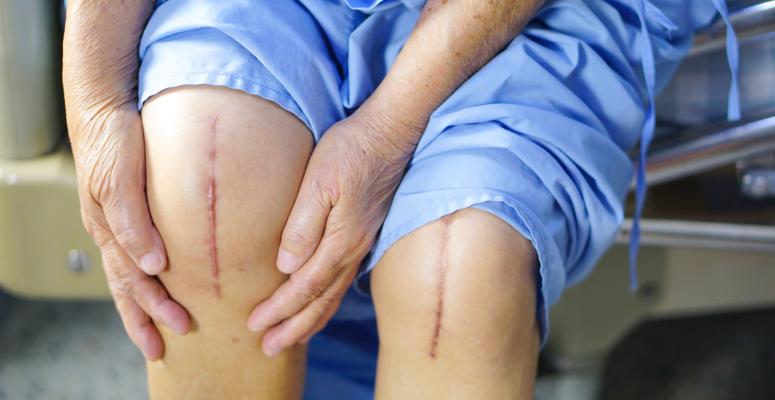
About 100 million people in the Western world develop scars each year. Scars occur after an injury to the dermis, or deep layer of skin. The body forms new collagen fibers to close and heal the wound. These fibers form scars, or new skin at the wound site, and they often have a different color and texture than the surrounding area. Some of the most common types of scar tissue include:
- Fine-line scars — These scars normally appear after a minor wound. They may start as a raised line above the skin and flatten over time. These scars are not painful, but they can be itchy in the beginning stages.
- Keloid scars — Keloid scars occur when the skin around a wound continues growing after the wound has already healed. This type of scar tissue is often raised above the skin and can be itchy, painful, hard and tight.
- Hypertrophic scars — Similar to keloid scars, an overgrowth of collagen causes hypertrophic scars. However, while keloid scars can grow beyond the point of the wound, hypertrophic scars do not. They are raised above the skin, but they usually don’t continue growing above 4 millimeters. They can be itchy and painful, but not as intensely as keloid scars.
- Contracture scars — Contracture scars occur after damage to a large area of skin, such as a burn. This type of scar tightens the skin around the wound and limits the mobility of joints and muscles. Movement with a contracture scar can therefore be painful.
Why does scar tissue hurt?
While scar formation is the body’s natural response to skin trauma, some scar tissue can be extremely painful. A scar’s pain intensity can be linked to the severity of the wound, complications of the healing process and hereditary factors.
Some types of scar tissue, like keloids and contractures, can tighten and pull on surrounding skin and joints. This can restrict movement and make daily activities incredibly uncomfortable. In addition, some scar tissue can be especially painful and sensitive if the injury involved nerve damage and the body developed new nerve endings.
Scar tissue pain can be linked to other symptoms, including:
- Swelling.
- Discoloration, such as redness.
- Itchiness.
- Throbbing sensations.
- Extreme sensitivity.
- Sense of tightness.
- Difficulty of moving joints.
How can you relieve scar tissue pain?
Scar tissue pain can be debilitating and restricting. Thankfully, several methods of treatment can help patients regain movement and confidence after burns, cuts, surgeries, bites, and skin conditions. The following treatments can help alleviate scar tissue pain and its related symptoms:
- Manual therapy — Manual therapy refers to hands-on physical therapy techniques that target problem areas. Soft tissue mobilization in particular can help physical therapists loosen tight and painful tissue like scars. Physical therapists can apply sustained or rhythmic pressure to increase blood flow to the area and decrease the scar’s tight hold on surrounding tissue. Patients can therefore experience better mobility over time.
- Compression — Medical professionals often recommend compression treatment when treating scar tissue patients. This is because sustained pressure can help decrease scar tissue inflammation. Compression can also help reduce scar tissue size and collagen buildup. By decreasing collagen buildup specifically, patients can reduce scar tightness over time and ease pain. A study found that using compression wraps is one of the most evidence-based ways to manage painful scar tissue.
- Dry needling — Dry needling is a technique that targets muscles, myofascial trigger points, and surrounding tissue to reduce pain and inflammation. During a dry needling session, a thin, monofilament needle is inserted into muscles or scar tissue. Many physical therapy practices use dry needling to help ease pain and encourage blood flow to inflamed scar tissue. Studies have shown that dry needling techniques can alleviate scar tissue pain and inflammation.
- Exercises and stretching — Since scar tissue can tighten the areas around joints and muscles, even simple movements can be painful. However, physical therapy can help patients regain their mobility and reduce pain while moving. Physical therapists can curate an exercise and stretching routine according to the type of scar and connected symptoms. Over time, exercise can lengthen scar tissue and reduce joint stiffness and pain.
Alliance PTP is ready to help you find top-notch PT for your scar tissue pain
At Alliance Physical Therapy Partners, we’re proudly bringing together physical therapy practices across the country to help people get the high-quality PT they need. Want to see a physical therapist in person? We can put you in touch with an Alliance PTP partner that’s close to you and that can help you address your scar tissue pain.
Not keen on in-person PT sessions or not close to an Alliance PTP partner? No worries. We also offer effective and affordable virtual physical therapy through our Agile Virtual Physical Therapy platform.
Contact our team today so we can help you find the most effective physical therapy services for your scars.
Get Help at a Location Near You
